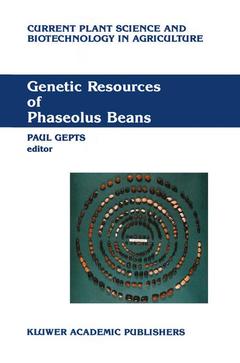Description
Genetic Resources of Phaseolus Beans, Softcover reprint of the original 1st ed. 1988
Their maintenance, domestication, evolution and utilization
Current Plant Science and Biotechnology in Agriculture Series, Vol. 6
Coordinator: Gepts Paul
Language: English
Keywords
agriculture; base; crop improvement; development; evolution; food; nutrition; plant
Publication date: 10-2011
614 p. · 15.5x23.5 cm · Paperback
614 p. · 15.5x23.5 cm · Paperback
Description
/li>Contents
/li>
The period following the second world war has witnessed an expanding commitment to incr~ased food production in tropical countries. Public and private initiatives at the national and international levels have led to the creation of programs geared specifically towards the improvement of food crops in tropical conditions. Examples of this increased commitment are the network of international agricultural research centers and numerous bilateral aid projects. As a consequence, crop improvement has become a truly worldwide endeavor, relying on an international network of institutions and collaborators. This holds also for Phaseolus beans. Following the discovery of the Americas, Phaseolus beans became distributed on all six continents. Yet, until not so long ago, most of the research on Phaseolus improvement took place in developed countries. In recognition of the nutritional importance of Phaseolus beans in developing countries, this has changed considerably in the last years, principally perhaps through the activities of the Centro Internacional de Agricultura Tropical (CIAT) and the International Board for Plant Genetic Resources (IBPGR). Consequently, the scope of the research on Phaseolus has broadened considerably and the number of Phaseolus researchers is larger than ever before.
Section I: Phaseolus Germplasm Exploration and Maintenance.- Phaseolus Germplasm Exploration.- Phaseolus Seed Storage Methodologies.- A Centralized Database for the Common Bean and Its Use in Diversity Analysis.- The Phaseolus World Collection.- A Base Collection of wild and Botanical Forms of Phaseoleae-Phaseolinae.- The International Phaseolus Germplasm Network.- Section II: Domestication and Evolution of Phaseolus sp. with Special Reference to P. vulgaris.- Phaseolus in Archaeology.- Morphological, Physiological, and Biochemical Changes in Phaseolus Beans under Domestication.- The Wild Relative of Phaseolus vulgaris in Middle America.- The Wild Ancestor of Phaseolus vulgaris in South America.- Phaseolin as an Evolutionary Marker.- Section III: Genetics of Phaseolus Vulgaris.- Genotypic and Phenotypic Markers in Common Bean.- Linkage Mapping of Marker Genes in Common Bean.- Genetic Structure of Bean Landraces in Malawi.- A Middle American and an Andean Common Bean Gene Pool.- Section IV: Genetic Resources, Domestication, and Evolution of Other Cultivated Phaseolus Species.- Genetic Resources, Domestication, and Evolution of Lima Bean (Phaseolus lunatus).- Evolution and Diversity of Phaseolus acutifolius Genetic Resources.- Variation, Taxonomy, Domestication, and Germplasm Potentialities in Phaseolus coccineus.- Section V: Utilization of Phaseolus Genetic Resources.- Phaseolus Genetic Resources and Breeding in Brazil.- Interspecific Hybridization between Phaseolus vulgaris and P. acutifolius.- Selection Methods in the Common Bean (Phaseolus vulgaris).- Transfer of Quantitative Traits in Wide Crosses Involving the Common Bean (Phaseolus vulgaris).- Utilization of Genetic Resources in the Development of Commercial Bean Cultivars in the U.S.A..- Color Plates.
© 2024 LAVOISIER S.A.S.




